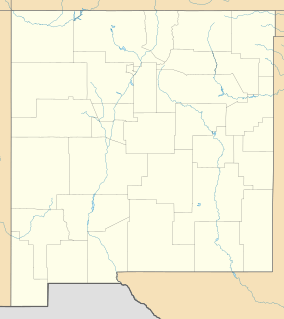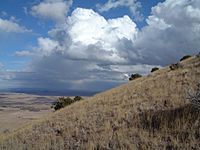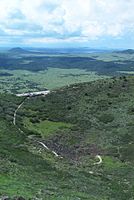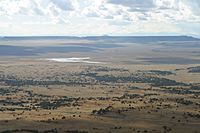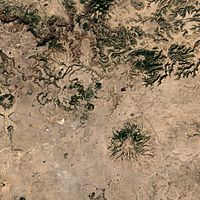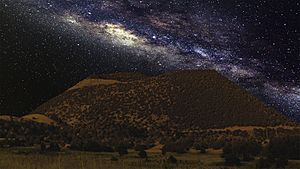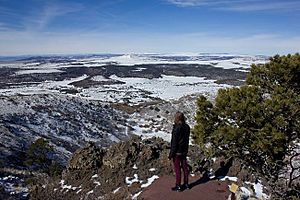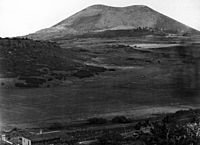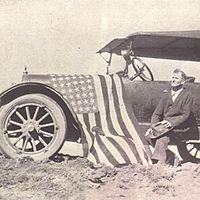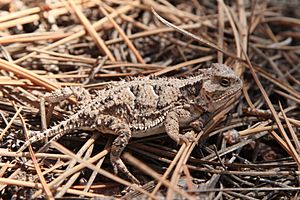Capulin Volcano National Monument facts for kids
Quick facts for kids Capulin Volcano National Monument |
|
|---|---|
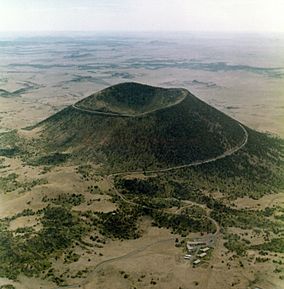
Last erupted between 55,000 to 62,000 years ago
|
|
| Location | Raton-Clayton Volcanic Field, Union County, New Mexico, New Mexico, United States |
| Area | 793 acres (321 ha) |
| Elevation | 2,494 m (8,182 ft) |
| Max. elevation | 8,182 |
| Authorized | August 9, 1916 |
| Visitors | 67,442 (in 2018) |
| Governing body | Department of the Interior |
| Website | Capulin Volcano National Monument |
Capulin Volcano National Monument is a special place in northeastern New Mexico. It protects an extinct volcano called a cinder cone. This volcano is part of a larger area known as the Raton-Clayton Volcanic Field.
You can drive a paved road that winds up the volcano to a parking lot at its top. From there, you can walk trails around the rim or even hike down into the volcano's mouth. This monument was created on August 9, 1916. The National Park Service takes care of it. The volcano is about 5 kilometers (3 miles) north of a small village named Capulin.
The visitor center has cool exhibits about the volcano. You can learn about the area's geology (how the Earth is made), its nature, and its history. They also offer educational programs and show a video about the volcano. The name Capulin comes from a type of choke cherry tree. This tree, called Prunus virginiana, grows naturally in southern North America.
Did you know that some Apollo 16 astronauts trained here? John Young and Charlie Duke visited in May 1971. They learned about geology from experts like William R. Muehlberger.
Contents
What is Capulin Volcano?
Capulin Volcano National Monument is home to a very well-preserved volcano. It's quite young, having last erupted between 55,000 and 62,000 years ago. The volcano rises steeply from the flat grasslands around it. It reaches a height of 2,494 meters (8,182 feet) above sea level.
The top of the crater is about 1.6 kilometers (1 mile) around. The crater itself is about 120 meters (400 feet) deep. Capulin Volcano is a famous landmark in northeastern New Mexico. It's where the rolling grasslands meet the foothills of the Sangre de Cristo Mountains.
From the highest point of Capulin Volcano, you can see amazing views. You can look out over the entire volcanic field. On clear days, you might even spot distant snow-capped mountains. You can also see parts of five different states: New Mexico, Oklahoma, Kansas, Texas, and Colorado.
Capulin Volcano is a great place to learn about how volcanoes form. The large volcanic area around the monument has at least 100 other volcanoes. This helps visitors understand 10 million years of northern New Mexico's geological past.
Fun Things to Do at Capulin Volcano
A popular activity is driving the 3.2-kilometer (2-mile) road. It winds from the bottom of the volcano all the way to the top. Once you reach the summit, you'll see incredible views. You can look out at the surrounding volcanic field and the Sangre de Cristo Mountains. You'll also spot different plants and animals.
From late June to early August, something cool happens. Thousands of ladybugs gather on trees and bushes at the top of the volcano. This is called hilltopping. Capulin is also certified as a Gold Tier Dark-Sky Park. This means it has one of the darkest night skies in the country. Because there's very little light pollution, you can see amazing views of the Milky Way and many constellations.
Visitors can also hike on several trails in the park. The Lava Flow trail is a 1.6-kilometer (1-mile) loop. It runs along the southern part of the park. The Boca Trail is a 2.7-kilometer (1.7-mile) loop. It goes along the western base of the volcano. On this trail, you can see collapsed lava tubes. These were formed thousands of years ago at the volcano's base.
There are two trails you can access from the top of the volcano. The Crater Rim trail is a 1.6-kilometer (1-mile) loop. It goes all the way around the rim of the volcano. The Crater Vent trail goes 180 meters (200 yards) into the crater itself.
History of the Monument
On August 9, 1916, President Woodrow Wilson officially made Capulin a U.S. National Monument. He wanted to protect this "striking example of recent extinct volcanoes." He felt it was very important for science and geology.
Local ranchers, like Jessie Foote Jack, valued Capulin Volcano. They used it as good land for grazing cattle. Jessie used her husband's political connections to become the monument's first custodian. She served from 1916 to 1921. Jessie Foote Jack was also the first female custodian in the National Park Service.
In 1921, Homer Farr unofficially took over as custodian. He officially got the job in 1923 and worked for the National Park Service until 1955. Homer Farr was very enthusiastic about the volcano. He brought many changes to the monument. He helped build the road to the rim. He also got money for improvements during tough economic times. During the Great Depression, he even started a project to stabilize the road and build retaining walls.
In 1987, Congress changed the monument's name. It went from Capulin Mountain National Monument to Capulin Volcano National Monument. This change recognized the volcano's importance.
Animals and Plants
Capulin Volcano is famous for its geology. But it also has a wide variety of plants and animals. The grasslands of the Great Plains meet the forests of the Rocky Mountains here. This creates a special "ecotone" (a place where two different habitats meet). This unique area provides a home for 73 types of birds. Many other animals also live here.
You can find songbirds like the spotted towhee, Bullock's oriole, mountain bluebird, and Steller's jay. Larger birds like the wild turkey, osprey, and red-tailed hawk also live at Capulin. New Mexico's state bird, the roadrunner, is here too. Five different kinds of hummingbirds migrate through Capulin in the summer.
Some larger mammals that visit the park include the American black bear, cougar, pronghorn, and elk. The most common large mammal is the mule deer. Smaller mammals also call Capulin Volcano National Monument home. These include the American badger, Mexican free-tailed bat, ring-tailed cat, desert cottontail, and North American porcupine.
The unique landscape and plants create a habitat. This allows many different animals to live together in a small area. The variety of life isn't just warm-blooded animals. Capulin also has many cold-blooded reptiles. You might see prairie rattlesnakes and bullsnakes. western fence lizards and horned lizards like to sunbathe on the hiking trails. Sometimes, tiger salamanders are spotted in pools of water.
Images for kids


